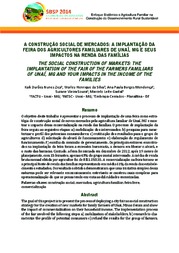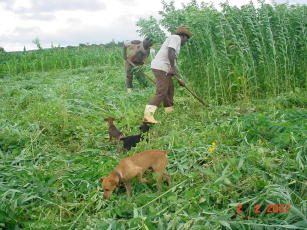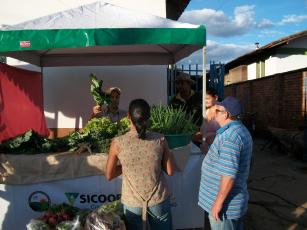A construção social de mercados: a implantação da Feira dos Agricultores Familiares de Unaí, MG e seus impactos na renda das famílias.
A construção social de mercados: a implantação da Feira dos Agricultores Familiares de Unaí, MG e seus impactos na renda das famílias.
Author(s): ZICA, K. D. N.; SILVA, W. H. de; MENDONÇA, A. P. B.; SOUZA, S. V.; GASTAL, M. L.
Summary: O objetivo deste trabalho é apresentar o processo de implantação de uma feira como estratégia de construção social de novos mercados pela agricultura familiar de Unaí, MG e mostrar o impacto dessa comercialização na renda das famílias. O processo de implantação da feira seguiu as seguintes etapas: a) mobilização dos interessados; b) pesquisa para caracterizar o perfil dos potenciais consumidores; c) restituição dos resultados para o grupo de agricultores; d) solicitação do alvará de funcionamento; e) elaboração do regulamento de funcionamento; f) escolha da comissão de gerenciamento. Os principais entraves encontrados na implantação da feira foram a excessiva burocracia, a demora em liberar o alvará, e o custo das barracas. Contudo, a feira foi iniciada em dezembro de 2012, após 19 meses de planejamento, com 15 feirantes, apenas 43% do grupo inicial interessado. A média de renda bruta mensal obtida por agricultor foi de R$ 1.053,55. A comercialização na feira tornou-se a principal fonte de renda das famílias representando em média 61% da renda dos estabelecimentos estudados. Os resultados obtidos demonstraram que uma iniciativa simples dessa natureza pode ser relevante economicamente, entretanto se mostrou mais complexo para operacionalização do que se pensa tendo em vista as dificuldades encontradas. Abstract: The goal of this project is to present the process of deploying a city fair as social construction strategy for the creation of new markets for family farmers of Unai, Minas Gerais and show the impact of commercialization on their household income. The implementation process of the fair involved the following steps: a) mobilization of stakeholders, b) research to characterize the profile of potential consumers c) refund the results for the group of farmers, d) request business license e) preparation of the operating rule, f) choice of the management committee. The main obstacles encountered in the implementation of the fair were excessive bureaucracy, the delay in releasing the license, and the cost of the tents. However, the fair started in December 2012, after 19 months of planning, with 15 stallholders, only 43% of the initial group concerned. The average monthly gross income per farmer was R$ 1,053.55. The sale at the fair became the main source of income of households representing on average 61% of the income of the studied establishments. The results showed that such a simple initiative can be economically relevant, however proved more complex to operationalize than one would think in view of the difficulties encountered.
Publication year: 2014
Types of publication: Paper in annals and proceedings
Unit: Embrapa Cerrados
Keywords: Agricultura Familiar, Comercialização, Construção social, Feira livre, Mercados
Observation
Some of Embrapa's publications are published as ePub files. To read them, use or download one of the following free software options to your computer or mobile device. Android: Google Play Books; IOS: iBooks; Windows and Linux: Calibre.
Access other publications
Access the Agricultural Research Database (BDPA) to consult Embrapa's full library collection and records.
Visit Embrapa Bookstore to purchase books and other publications sold by Embrapa.




